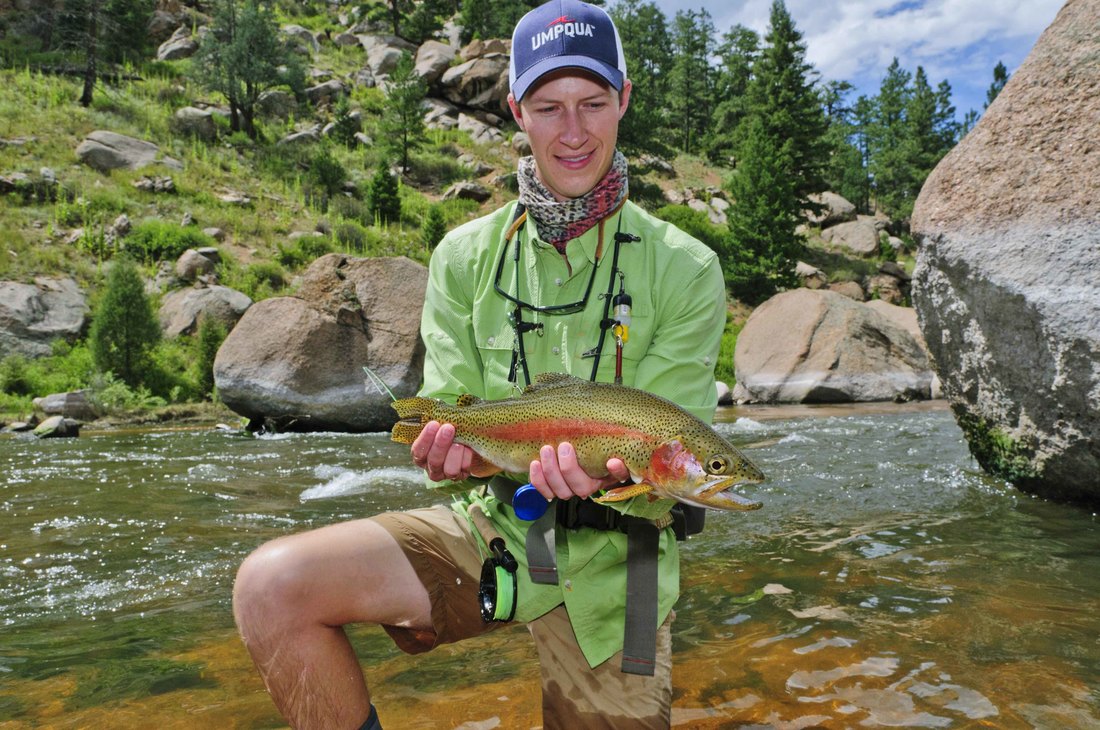Cheesman Canyon

14 Day Forecast: Look for hatches of midges, blue-winged olives, and pale morning duns.
Effective Patterns: #20-22 Jujubaetis, #18 Barr Emerger PMD, #18 Split Case Caddis, #18-20 Top Secret Baetis, #20 Top Secret Midge, #22 Black Beauty, #22 Zebra Midge, #18-20 Pale Olive Midge Larva, #20-22 Chocolate Foam Wing Emerger, #20-22 Mercury Midge, #16-20 Sparkle Dun, #16-18 Mole Fly, #20 Parachute BWO, #20 Hi-Vis Baetis,#20-22 Parachute Adams, #16 Graphic Caddis, #16 Elk Hair Caddis, and #16 Goddard Caddis.
Measurements
Stream Conditions & Tips from Pat Dorsey for Fly Fishing Cheesman Canyon in Colorado
The picturesque boulder-filled Cheesman Canyon portion of the South Platte River is considered by many one of the most pristine fisheries in the world. This area, often times simply referred to, as “the Canyon” is an experience you’ll never forget. It’s the perfect scenario, magnificent beauty in combination with great fly fishing.
The South Platte River carves its way through a granite canyon lined with ponderosa pines, willows, fallen tree trunks, and various other assorted ground foliages. Boulders as big as Volkswagens Beetles create structure for the super-selective trout residing in the river. Mule Deer, Black Bear, Raccoons, Mountain Lyons, and Bald Eagles all add to the experience. Anglers can expect to catch mostly large rainbows supplemented with a few nice brown trout. The aforementioned “canyon” is as technical as they get, and if you can catch trout here, you can catch them anywhere in the world. This three-mile section is primarily a nymphing fishery requiring tiny midge and mayfly imitations with fine 5 and 6X tippets. Ideal flows for Cheesman Canyon are between 250 and 400 cfs. The regulations are flies and lures only. All fish must be returned to the water immediately.
Cheesman Canyon is one of the best tailwaters in the country. There's a common belief among "canyon regulars" that if you can catch fish on the South Platte River, you can fool fish anywhere in the world. There's no substitution for good technique in Cheesman Canyon.
Tips & Other Information:
Outflows were reduced to 145 cfs below Cheesman Reservoir. Cheesman Reservoir is at 86% capacity as of this morning. Cheesman Reservoir is turning over and the water is murky. Water temps are currently in the high 50’s and low 60’s. The hathes are all messed up with warmer water…caddis and pmD’s are coming off, and as you might expect, really good midge and blue winged olive hatches are taking place. The midge hatches are simply amazing right now. Size 22-24 Mercury Midges, Black Beauties, and Top Secret Midges have been the flies of choice lately for the midge-bite. Top Secret Baetis, Stalcup’s Baetis, Barr Emerger PMD, and Chocolate Foam Wing Emergers are a good choice when you start to see some mayflies coming off. Certain sections are getting difficult to nymphs with all the aquatic vegation.If you are fortunate enough to find a few risers, it’s hard to go wrong with a Sparkle Dun, Para BWO (PMD), Hi-Vis Baetis (PMD), Mole Fly, Blue Quill, Blue Dun, or Para Adams in sizes 18-20. Overcast days and inclement weather are producing the best hatches. Revised 10/21/25
